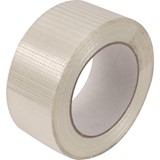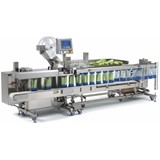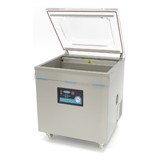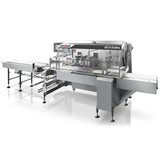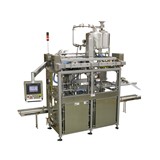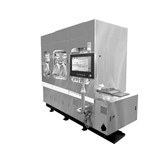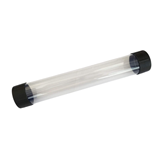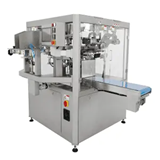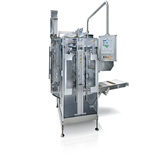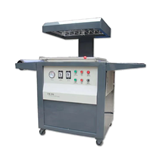Every year some 1.3 billion tonnes of food ends up in the bin. While half of that total is lost during production, time-poor households are still the largest generator of food waste to landfill, throwing away 2.7 million tonnes of food in Australia each year. In Europe and North America 100kg of food is thrown away per person each year, even though it is still fit for consumption.
Food spoilage is a major culprit, and packaging technology companies are now devoting significant R&D dollars to the development of active, intelligent packaging solutions for pre-packaged and processed foods.
TV Dinners come of age
It was as long ago as the 1950s when the term "TV dinner" was coined. The various food groups in a TV dinner were displayed neatly in a divided aluminium tray, and consumers loved them. They were convenient, they were simple, and they quickly became a pop culture phenomenon.
The original TV dinner brand did away with the name as early as the 1960s, and while no food manufacturer would dream of marketing its ready meals as a TV dinner today, the demand for quick, easy-to-prepare processed meals is greater today than it ever was.
The packaging industry has kept pace, focusing on the development of solutions that provide maximum food security while maintaining nutritional value at competitive prices, and that has demanded a dramatic shift from traditional to advanced packaging.
Traditional vs advanced packaging
Traditional packaging only addresses issues related to protection from external factors. However, advanced packaging interacts internally (active packaging) and externally (intelligent packaging) with the environment and enhances the visual appeal of the products.
Active packages interact with their contents. For example, PET bottles are treated with oxygen absorbers like iron so that oxygen-sensitive beverages such as beer and fruit juice keep for longer. Then there are films enriched with preservatives like sorbic acid that combat germ proliferation on foods.
On the intelligent packaging side, examples include labels containing a special pigment printed straight onto a package which change colour when the contents spoil or reach a certain temperature.
Reducing food waste
According to a recent study by the Royal Melbourne Institute of Technology (RMIT), this innovative packaging is the key to both reducing food waste and meeting consumer demand for convenience foods.
"There are certainly opportunities to minimise food waste through packaging innovation and design, such as improved ventilation and temperature control for fresh produce, and better understanding the dynamics between different levels of packaging, to ensure they are designed fit-for-purpose," study leader and RMIT Senior Research Fellow, Associate Professor Karli Verghese, told IndustrySearch.
"In doing so it helps deliver a wide range of functions while reducing food waste."
While product spoilage and shelf life are the subject of many of the advanced packaging technologies, Dr Verghese said food processors and packaging companies also needed to look at serving sizes and consumer acceptance of new packaging technologies.
"We need to understand how the consumer interacts and uses packaging and the food within it," Verghese said.
"What is the volume or dosage in the pack, is it a glass jar or a plastic pouch or PET bottle, is the consumer going to use all of that at once or incremental amounts over a period of time?
"We looked at yoghurt, a 1kg tub, a 6-pack multi-pack and then the little 90g flexible pouches. Of the pouches there was about ten per cent of the yoghurt that remained in the pouch after consumption.
"That's where there is an opportunity. It's an unseen component of waste, it's not even quantified in the stats that are out there.
"If you look in the Australian Packaging Covenant there's actually one question in the sustainable packaging guidelines that says how much of the product remains in the pack? If manufacturers don't know that then they should be starting to investigate it because there's an opportunity there.
"Why waste, you put all the resources into making it and ten per cent of it remains in the pack – that's 10g out of a 90g pack, multiply that out and it's a big number."
Consumer education
While advanced packaging has a role to play, Verghese said this had to be done hand-in-hand with consumer education if it was to have the desired effect on reducing waste.
"It comes down to consumer acceptance of packaging technologies. Some recent research out of the UK looked at consumers' understanding of packaging, and people seeing their lettuce in a pack and thinking to make it last longer they need to open the pack to let it breathe," Verghese said.
"There is this disconnect. There are various packaging technologies and systems and materials out there but then you've got this gap with consumers not understanding.
"For example not being told on the pack 'make sure you seal this and it will extend the shelf life', so there is a role there from the brand owner or packaging company to indicate to the consumer how to interact with that packaging to extend shelf life."
According to the peak body for the food processing sector, the Australian Food and Grocery Council (AFGC), Verghese's study is a welcome addition to a field of research that can allow food processors and packagers to not only reduce food waste, but improve their own efficiencies at the same time.
"The findings reinforce industry's commitment to design and use packaging to move goods from production to consumption without damage while using minimum resources and generating the least amount of waste, through sustainable design," AFGC CEO, Gary Dawson, said.
"Harnessing the findings of this study to produce packaging that protects food as it moves through the supply chain, and that also extends shelf-life for the consumer, provide further opportunities to improve efficiencies for industry."
Cost to industry
However, according to Lee Wright, an independent packaging consultant to the food industry, the downside of many food-saving packages is that they are relatively expensive to produce. As a result, he says, the sector is trying to offset the expenditure on smarter packages by economising elsewhere along the food value chain.
"There is a huge opportunity in the advanced packaging technology market, not just in food and beverages but for pharmaceuticals and beauty products as well, but the cost of implementing this technology is holding the industry back," Wright told IndustrySearch.
"The market in Australia is fragmented, and that means smaller production runs, which in turn means Australian companies don't benefit from the same economies of scale as their counterparts in the US or Europe."
What next?
Still, Wright says, the future of advanced packaging is an exciting one.
"Intelligent, smart and active packaging is slowly replacing traditional methods, and it's only going to get bigger," Wright said.
"Nanotechnology is still emerging. Nanostructures that enhance the vapour permeability of plastics, nanosensors that can help detect pathogens and toxins, these sorts of technologies will have a big role to play in the future.
"Not only will they meet consumer demand, they are going to help us significantly reduce food waste."
- Suppliers
- New to IndustrySearch? Book a Demo
- Advertise with us
- Login
- Email Marketing
- Buyers
- Get Quotes
- Articles & Ideas
- Login
- Subscribe to newsletter
- My Details
- Get Quotes
- Automation & Control
- Automotive Workshop Equipment
- Commercial Cleaning & Laundry Supplies
- Construction Equipment & Heavy Machinery
- Conveyor Systems & Components
- Electrical & Power Generation Equipment
- Electronic Components
- Farming & Agriculture
- Food & Beverage Processing
- Forklifts & Forklift Attachments
- Hydraulic & Pneumatic Equipment
- Industrial Materials, Tools & Components
- Industrial Pumps
- IT Hardware & Industrial Computing
- IT Software & Applications
- Laboratory Equipment & Instruments
- Manufacturing & Industrial Equipment
- Material Handling & Lifting Equipment
- Meat Processing Equipment
- Metalworking & Machining
- Mining Equipment & Machinery
- Packaging & Labelling Machinery
- Pallet Handling Equipment
- Personal Protective Equipment
- Security & Surveillance
- Test & Measurement
- Transport & Logistic Equipment
- Warehouse Storage, Shelving & Racking
- Waste Treatment & Environmental Management
- Welding Machines & Accessories
- Woodworking & Joinery Machines
- Workplace Equipment
- Workplace Safety Equipment
- Get Quotes
- Automation & Control
- Automotive Workshop Equipment
- Commercial Cleaning & Laundry Supplies
- Construction Equipment & Heavy Machinery
- Conveyor Systems & Components
- Electrical & Power Generation Equipment
- Electronic Components
- Farming & Agriculture
- Food & Beverage Processing
- Forklifts & Forklift Attachments
- Hydraulic & Pneumatic Equipment
- Industrial Materials, Tools & Components
- Industrial Pumps
- IT Hardware & Industrial Computing
- IT Software & Applications
- Laboratory Equipment & Instruments
- Manufacturing & Industrial Equipment
- Material Handling & Lifting Equipment
- Meat Processing Equipment
- Metalworking & Machining
- Mining Equipment & Machinery
- Packaging & Labelling Machinery
- Pallet Handling Equipment
- Personal Protective Equipment
- Security & Surveillance
- Test & Measurement
- Transport & Logistic Equipment
- Warehouse Storage, Shelving & Racking
- Waste Treatment & Environmental Management
- Welding Machines & Accessories
- Woodworking & Joinery Machines
- Workplace Equipment
- Workplace Safety Equipment
Trusted by 1.2 million Australian industrial buyers
Buyers
- Discover products & solutions
- Login
- Subscribe To Newsletter
- Browse All Products
- Read Articles
Suppliers
Advertise
- Promote your products & solutions
- New to IndustrySearch? Book a Demo
- Login / Forgot Password
- Advertise Your Products
- Success Stories
- Email Marketing
- Suppliers
- Advertise with us
- Login
- Email Marketing
- Buyers
- Get Quotes
- Articles & Ideas
- Login
- Subscribe to newsletter
- My Details
Get Quotes
- Automation & Control
- Automotive Workshop Equipment
- Commercial Cleaning & Laundry Supplies
- Construction Equipment & Heavy Machinery
- Conveyor Systems & Components
- Electrical & Power Generation Equipment
- Electronic Components
- Farming & Agriculture
- Food & Beverage Processing
- Forklifts & Forklift Attachments
- Hydraulic & Pneumatic Equipment
- Industrial Materials, Tools & Components
- Industrial Pumps
- IT Hardware & Industrial Computing
- IT Software & Applications
- Laboratory Equipment & Instruments
- Manufacturing & Industrial Equipment
- Material Handling & Lifting Equipment
- Meat Processing Equipment
- Metalworking & Machining
- Mining Equipment & Machinery
- Packaging & Labelling Machinery
- Pallet Handling Equipment
- Personal Protective Equipment
- Security & Surveillance
- Test & Measurement
- Transport & Logistic Equipment
- Warehouse Storage, Shelving & Racking
- Waste Treatment & Environmental Management
- Welding Machines & Accessories
- Woodworking & Joinery Machines
- Workplace Equipment
- Workplace Safety Equipment
Get Quotes
- Automation & Control
- Automotive Workshop Equipment
- Commercial Cleaning & Laundry Supplies
- Construction Equipment & Heavy Machinery
- Conveyor Systems & Components
- Electrical & Power Generation Equipment
- Electronic Components
- Farming & Agriculture
- Food & Beverage Processing
- Forklifts & Forklift Attachments
- Hydraulic & Pneumatic Equipment
- Industrial Materials, Tools & Components
- Industrial Pumps
- IT Hardware & Industrial Computing
- IT Software & Applications
- Laboratory Equipment & Instruments
- Manufacturing & Industrial Equipment
- Material Handling & Lifting Equipment
- Meat Processing Equipment
- Metalworking & Machining
- Mining Equipment & Machinery
- Packaging & Labelling Machinery
- Pallet Handling Equipment
- Personal Protective Equipment
- Security & Surveillance
- Test & Measurement
- Transport & Logistic Equipment
- Warehouse Storage, Shelving & Racking
- Waste Treatment & Environmental Management
- Welding Machines & Accessories
- Woodworking & Joinery Machines
- Workplace Equipment
- Workplace Safety Equipment
Trusted by 1.2 million Australian industrial buyers




